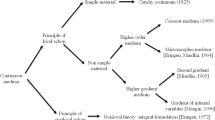Abstract
This paper deals with the reduced order modeling of micromorphic continua. The reduced basis model relies on the proper orthogonal decomposition and the hyper-reduction. Two variants of creation of reduced bases using the proper orthogonal decomposition are explored from the perspective of additional micromorphic degrees of freedom. In the first approach, one snapshot matrix including displacement as well as micromorphic degrees of freedom is assembled. In the second approach, snapshots matrices are assembled separately for displacement and micromorphic fields and the singular value decomposition is performed on each system separately. Thereafter, the formulation is extended to the hyper-reduction method. It is shown that the formulation has the same structure as for the classical continua. The relation of higher order stresses introduced in micromorphic balance equations to creation of the reduced integration domain is examined. Finally, the method is applied to examples of microdilatation extension and clamped tension and to a size-dependent stress concentration in Cosserat elasticity. It is shown that the proposed approach leads to a good level of accuracy with significant reduction of computational time.





























Similar content being viewed by others
References
Mindlin RD (1964) Micro-structure in linear elasticity. Arch Ration Mech Anal 16:3
Eringen AC, Suhubi E (1964) Nonlinear theory of simple micro-elastic solids—I. Int J Eng Sci 2(2):189–203
Eringen AC, Suhubi E (1964) Nonlinear theory of simple micro-elastic solids—II. Int J Eng Sci 2(2):389–404
Forest S, Sievert R (2006) Nonlinear microstrain theories. Int J Solids Struct 43(24):7224–7245
Almroth B, Stern P, Brogan F (1978) Automatic choice of global shape functions in structural analysis. AIAA Journal 16(5):525–528
Cuong NN, Veroy K, Patera AT (2005) Certified real-time solution of parametrized partial differential equations. In: Sidney Y (ed) Handbook of materials modeling: methods. Springer, Dordrecht, pp 1529–1564
Ryckelynck D (2005) A priori hyperreduction method: an adaptive approach. J Comput Phys 202(1):346–366
Ryckelynck D (2009) Hyper-reduction of mechanical models involving internal variables. Int J Numer Methods Eng 77(1):75–89
Ryckelynck D (2009) Hyper reduction of finite strain elasto-plastic models. Int J Mater Form 2(1):567–571
Hernández J, Oliver J, Huespe AE, Caicedo M, Cante J (2014) High-performance model reduction techniques in computational multiscale homogenization. Comput Methods Appl Mech Eng 276:149–189
Georgiou I (2005) Advanced proper orthogonal decomposition tools: using reduced order models to identify normal modes of vibration and slow invariant manifolds in the dynamics of planar nonlinear rods. Nonlinear Dyn 41(1–3):69–110
Farhat C, Avery P, Chapman T, Cortial J (2014) Dimensional reduction of nonlinear finite element dynamic models with finite rotations and energy-based mesh sampling and weighting for computational efficiency. Int J Numer Methods Eng 98(9):625–662
Forest S (2009) Micromorphic approach for gradient elasticity, viscoplasticity, and damage. J Eng Mech 135(3):117–131
Germain P (1973) La méthode des puissances virtuelles en mécanique des milieux continus. J Méc 12:236–274
Germain P (1973) The method of virtual power in continuum mechanics. Part 2: Microstructure. SIAM J Appl Math 25(3):556–575
Auffray N, Le Quang H, He Q-C (2013) Matrix representations for 3d strain-gradient elasticity. J Mech Phys Solids 61(5):1202–1223
Eringen AC (1968) Mechanics of micromorphic continua. In Kröner E (ed) Mechanics of generalized continua: proceedings of the IUTAM-Symposium on The Generalized Cosserat Continuum and the Continuum Theory of Dislocations with Applications, Freudenstadt and Stuttgart (Germany) 1967. Springer, Berlin, pp 18–35
Goodman M, Cowin S (1972) A continuum theory for granular materials. Arch Ration Mech Anal 44(4):249–266
Cosserat E, Cosserat F (1909) Théorie des corps déformables. Paris 3:17–29
Besson J, Cailletaud G, Chaboche J-L, Forest S (2009) Non-linear mechanics of materials, vol 167. Springer, Berlin
Sirovich L (1987) Turbulence and the dynamics of coherent structures. Part I: Coherent structures. Q Appl Math 45(3):561–571
Iollo A, Lanteri S, Désidéri J-A (2000) Stability properties of POD-Galerkin approximations for the compressible Navier–Stokes equations. Theor Comput Fluid Dyn 13(6):377–396
Lutowska A (2012) Model order reduction for coupled systems using low-rank approximations. PhD thesis, Eindhoven University of Technology
Fritzen F, Hodapp M, Leuschner M (2014) GPU accelerated computational homogenization based on a variational approach in a reduced basis framework. Comput Methods Appl Mech Eng 278:186–217
Chaturantabut S, Sorensen DC (2010) Nonlinear model reduction via discrete empirical interpolation. SIAM J Sci Comput 32(5):2737–2764
Maday Y, Rønquist EM (2002) A reduced-basis element method. J Sci Comput 17(1–4):447–459
Ryckelynck D, Gallimard L, Jules S (2015) Estimation of the validity domain of hyper-reduction approximations in generalized standard elastoviscoplasticity. Adv Model Simul Eng Sci 2(1):1
Patzák B, Bittnar Z (2001) Design of object oriented finite element code. Adv Eng Softw 32(10):759–767
Patzák B (2012) OOFEM—an object-oriented simulation tool for advanced modeling of materials and structures. Acta Polytech 52(6):59–66
Horák M, Patzák B, Jirásek M (2014) On design of element evaluators in OOFEM. Adv Eng Softw 72:193–202
Radermacher A, Reese S (2014) Model reduction in elastoplasticity: proper orthogonal decomposition combined with adaptive sub-structuring. Comput Mech 54(3):677–687
Kaloni PN, Ariman T (1967) Stress concentration effects in micropolar elasticity. Z Angew Math Phys 18(1):136–141
Dillard T, Forest S, Ienny P (2006) Micromorphic continuum modelling of the deformation and fracture behaviour of nickel foams. Eur J Mech A Solids 25(3):526–549
Mindlin R (1963) Influence of couple-stresses on stress concentrations. Exp Mech 3(1):1–7
Cowin SC (1970) An incorrect inequality in micropolar elasticity theory. Z Angew Math Phys 21(3):494–497
Acknowledgements
This study was carried out in the framework of project MICROMORFING (ANR-14-CE07-0035-03) funded by the Agence Nationale de la Recherche (ANR, France). This support is gratefully acknowledged.
Author information
Authors and Affiliations
Corresponding author
Rights and permissions
About this article
Cite this article
Horák, M., Ryckelynck, D. & Forest, S. Hyper-reduction of generalized continua. Comput Mech 59, 753–778 (2017). https://doi.org/10.1007/s00466-016-1371-2
Received:
Accepted:
Published:
Issue Date:
DOI: https://doi.org/10.1007/s00466-016-1371-2




